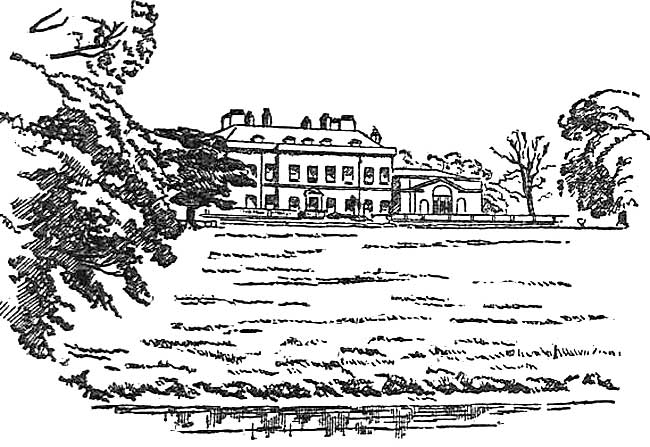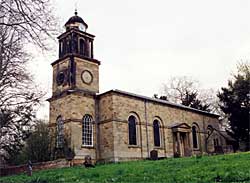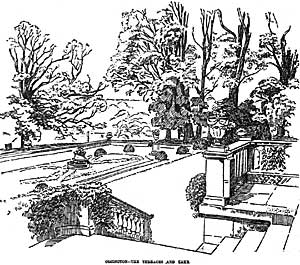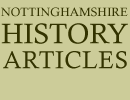ABOUT NOTTINGHAMSHIRE: ITS PLACES AND ITS PEOPLE,
by CORNELIUS BROWN, F.R.S.L., author of "LIVES OF NOTTS. WORTHIES" and
other works.
Chapter XXIX. Ossington and Laxton

Ossington Hall [the hall was demolished in 1963]
Very noteworthy are the associations of the little village of Ossington, standing embowered amidst a wealth of trees, and possessing one of the most picturesque of the stately homes which adorn our county. To the Hall there attaches a melancholy interest at this moment, for a few days ago there passed away, full of years and honours, the kind and most estimable lady to whom it belonged—Charlotte, Viscountess Ossington, the widow of the late Speaker of the House of Commons. Around the grave of this noble philanthropist in the quaint village church there gathered a memorable company of representative men to testify by their presence their deep sense of the irreparable loss which has been sustained through the demise of one so generous and large-hearted, and so ready to assist with an unstinted hand in every good work for the welfare of the people. While the recollection of this event is still fresh in the memory it seems a fitting time to say something in these notes of the place she loved so well, and of some of the neighbouring villages of which there are incidents to record of historic interest. Ossington, whose name the noble lady and her husband bore, is not one of those places that has materially changed its ancient cognomen. It was known as Oschinton before the Norman invasion, and in 1144 when Hugh de Burun, of the famous family of Burun or Byron, gave the church to the monastery of Lenton it was described as the church of "Oscinton," which name it bears with a slight variation in the orthography to this day. Hugh de Burun, like so many of the rich landowners of the time he lived in, gave freely of his wealth to the religious houses, and he had a younger son, Roger, who not only when his father gave a charitable gift was to be found gladly "praising the act," but himself "gave his body to God and the church of the Holy Trinity at Lenton." To be brief we may say that Roger became a Clugniac monk "that God might avert the scourge of wrath from him due for the great multitude of his sins," and having donned the habit of the order, he gave up to it the Church at Lenton and the whole town of Ossington with all its appurtenances. There was only one flaw in this bountiful act of charity, and that was that Ossington was not his to give,for he had already, in a previous fit of religious fervour, presented it to the Hospitallers of St. John of Jerusalem, who owned other properties in the locality. It was a curious oversight on the part of Roger de Burun to make a present twice over, and it brought the Clugniacs and the Knights of St. John into unpleasant collision. It "occasioned suits amongst the religious, especially for the Church,"and Thoroton has preserved for us an account of the trial of the cause, which for its quaint phraseology is worthy of transcription if only as a curious specimen of law reporting :—
"The prior of Lenton (9 John) produced the gift of Hugh de Burun, and confirmation of Roger, as it is before mentioned. The prior of the hospital of Jerusalem pleaded that they had seisin of the town of Oscinton where the church is situate, of the gift of Roger de Burun who gave them that town, and produced his charter testifying the same; and also another charter, which especially spoke concerning the church. The Prior of Lenton's atturney knew not that he should put) himself on the jury, before he had the advice of his master, and therefore day was given till fifteen days after Easter, at which time the jury found that Roper de Burun presented the last parson, which died, to the church of Oscington, and therefore the I brethren of the hospital should have their seisin, and the prior of Lenton be in mercy. Yet not very long before Roger Archbishop of York admitted and instituted Galfr, the clark, parson of this church upon the presentation of the prior and monks of Lenton, and gave them 2s. a year as a pension out of it. There was a fine levied at Leycester the Munday after the feast of St. Andrew that same year, viz. (10 John), between Peter, prior of Lenton, and Robert,the treasurer of the prior of the hospital of Jerusalem, concerning the advowson of this church which the prior of Lenton released to the hospitalers, and they gave to Lenton the moiety of the advowson of the church of Huneswithe of their gift.

Ossington church.
And so by a fair exchange the unseemly dispute came to an end, and Ossington was enjoyed by the Knights Hospitallers, until that period of disendowment came which saw them and most religious houses fleeced of their choicest possessions. In the 34th Henry VIII., Charles Duke of Suffolk had licence to alienate the manor and rectory to Richard Andrews, gent., and his heirs, the aforesaid Andrews being, we assume, the same speculative gentleman who obtained a lease of Blyth Priory, and who is described by an eminent authority as "among the chief monastic stock jobbers of the day."
On the demise of Andrews the manor passed to Edmund Cartwright, who had married for his second wife Andrews' daughter Agnes, his first wife, Anne Cranmer, having been a sister of the Archbishop of Canterbury. From Edmund Cartwright the property descended to his son George, and thence to his grand son William, who died in 1602, to whose memory and to his wife Grace there is a fine monument at the east end of Ossington Church. It bears in the centre panels the kneeling effigies of husband and wife, and in the lower panels the figures of their twelve children. The eldest son, Fulk Cartwright, married a daughter of Sir Henry Pierrepont, Knt., of Holme Pierrepont, who was also buried in the church, and had a brass erected to her memory. The Cartwrights continued at Ossington throughout the period of the civil war, when a portion of the house was destroyed, and it was not until 1753 that they parted with the property, some of them settling at Marnham Hall, a few miles away, as in our previous article on Marnham may be noted. The owners in 1753 were four heiresses, and these ladies sold Ossington to Mr. William Denison, an opulent merchant of Leeds, who took up his abode there, and was High Sheriff of the county in 1779. Mr. Denison, by the exercise of great diligence and sagacity, accumulated a large fortune, amounting, it is said, to three-quarters of a million. One of the successful enterprises attributed to him in several local publications may be thus described: When the great earthquake took place at Lisbon, swallowing up a large portion of the city, many of the inhabitants who escaped with their lives were left almost destitute of provisions and other necessaries. Mr. Denison happened to have at that time a ship heavily laden with such goods as the Lisbon people stood urgently in need of; and the captain of the vessel, who had heard of the calamity, sailed at once for the unlucky city, arriving there in advance of any other ship. The result was a ready sale at high prices of the whole of the cargo, and the realisation of a profit which has been stated to have been equivalent to a large fortune. That this is not mere tradition is assumed from the fact that when Mr. Denison died at Bath, after discharging his public duties faithfully and well, the monument erected to him in Ossington Church consisted of a full-length marble figure, standing on a pedestal, having a scroll in his hand, and underneath him the representation of a ship unloading in the Port of Lisbon. From this successful and worthy gentleman the estate passed, in 1782, to his brother Robert, and subsequently to his nephew, Mr. John Wilkinson, who assumed the name and arms of Denison, and was father of the late Speaker. Very rarely has it fallen to the lot of any man to be blessed with-so clever, so high-minded, and altogether so excellent a family as that of Mr. John Wilkinson-Denison. Several of his sons rose to distinguished eminence in the service of the country, and one and all possessed talents of no ordinary kind. Mr. John Evelyn Denison, the eldest son, became Speaker of the House of Commons. Mr. Edward Denison entered holy orders, and became Bishop of Salisbury. Mr. William Thomas Denison became Governor-General of the Australian Colonies, and received the honour of knighthood. Mr. Geo. Anthony Denison is the well-known Archdeacon Denison of Taunton, in whose interesting book, "Notes of my Life," many entertaining details are given of what he witnessed and experienced in his boyhood days at Ossington, Newark, and Southwell. Other members of the family have added to the laurels which encircle the name. Mr. Edward Denison, M.P., a son of the Bishop of Salisbury, was a yonng philanthropist of brilliant talents, and Lord and Lady Ossington will be long remembered with gratitude and affection.

Ossington -- the terraces and lake.
Since it passed, nearly a century and a half ago, into the hands of this eminent family, Ossington has been well cared for. The hall has been rebuilt, and the gardens and terraces laid out with great taste and skill. There is a charming lake near the mansion, where the wild fowl are wont to congregate at certain seasons in large numbers, and the view from the windows looking across the terraces is most picturesque. Our illustrations of this pleasant country seat and its artistic surroundings are from admirable photographs placed at our disposal by Mr. G. Green, photographer, Newark.
